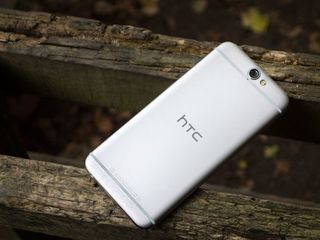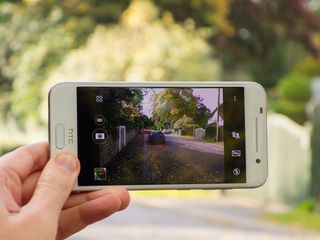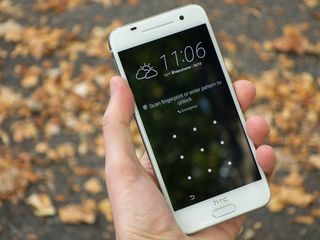HTC One A9 First Look

HTC is a company with a strong design pedigree. The Taiwanese phone maker was forging metal handsets back when the iPhone was a predominantly plastic affair, and in recent years it has produced some of the most head-turning Android smartphones of the time. The past 12 months, however, have seen rivals catch up in this important area, with the likes of Samsung, Motorola and Huawei shipping ever more impressive glass and metal-clad designs. And that's contributed to HTC's recent difficulties, as sales of the One M9 have fallen flat.
It's not time for a refreshed HTC flagship just yet, but in the interim we have a new member of the premium "One" family that aims to balance specs, design and cost. It's made of metal, runs Qualcomm's latest mid-range silicon and Google's latest OS, has a promising new camera setup — and, yes, looks just a bit like an iPhone.
Say hello to the HTC One A9.
Ask HTC and it'll tell you the A9 is an amalgam of many of its previous designs. The subtle brushed texture present on the back of the device can be traced back to 2014's M8, while the polished sides mirror those of the M9. HTC's being doing plastic antenna lines in metal phones since the M7. And the raised, centrally-placed rear camera? Kinda reminiscent of the China-centric One E9 from earlier in the year.
And yet show the A9 to the average person on the street and they'll tell you it looks like an iPhone 6 or 6s, pointing out the overall shape, antenna lines, camera design, tapered glass edges, LED flash design and port placements. It's a disservice to call the A9 a straight-up clone of the iPhone — and HTC would likely find itself in hot water even if it were — but there are undeniable similarities. So let's accept that, and move on.
Let's just accept that this thing looks like an iPhone, and move on.



Between the 5-inch screen size and curved metal edges, the HTC One A9 is a comfortable phone to hold and use. For a lot of consumers who don't want an enormous smartphone, a 5-inch screen remains the sweet spot — big enough for comfortable browsing and media consumption without being unwieldy. That's helped along by an ever-so-slight "step" between the curved sides and the largely flat back, which gives a little more purchase than the rounder sides of the iPhone. This is accompanied by a gentle change in texture and finish too, with the sides being more polished than the brushed matte effect of the rear. It's physically softer overall than the One M9, but without being as slippery as the M8.
Much ink will surely be spilled over who came up with which design feature first; regardless, the A9 looks and feels good. At 143 grams it's light but not insubstantial, and manages to feel like a premium handset without exuding the fragility of some rivals. The entire assembly feels balanced, with edges and joins that feel more organic than recent HTC phones. That trend continues around the front, with "2.5D" Corning Gorilla Glass 4 covering the front face, tapering down towards the edges with a pleasing curve.
Be an expert in 5 minutes
Get the latest news from Android Central, your trusted companion in the world of Android

Light but not insubstantial; 'premium' but not fragile.
The display itself is a 5-inch 1080p AMOLED panel, and while AMOLED on non-Samsung phones has been decidedly hit and miss, we've been impressed by the brightness and clarity of the A9's screen in our limited time with it thus far. (The panel maxes out at 500 nits, HTC tells us.) Below the display is a single-touch fingerprint reader, similar to what you'd find on an HTC One M9+, which also doubles as a secondary capacitive home key. We'll have more to say on the the fingerprint reader in our full review, but so far it seems to function exactly as advertised.
And yes, there's also an HTC logo sandwiched between the fingerprint scanner and the screen, in a way that makes the bottom portion of the phone look a little busy. That thin profile also means front-facing speakers are out of the question — instead there's a single downward-facing speaker on the bottom edge. HTC's BoomSound audio enhancements are included for listening over headphones though, and this time the manufacturer has bundled support for 24-bit, 192KHz high-resolution audio — including support for upscaling lower-res content.

Like previous HTC One devices, there's plenty of choice when it comes to colors. The A9 will come in four distinct hues — carbon grey, topaz gold, deep garnet, opal silver. We've been using the silver model, which comes with a white front face and accents, and HTC tells us that the finish of the metal will differ slightly depending on which color you pick up.
As for internals, HTC's packed in the latest mid-range processor from Qualcomm, the Snapdragon 617 — a 64-bit octa-core part with four cores at 1.5GHz and four at 1.2GHz. And that's paired with 2GB of RAM and 16GB of storage, or 3GB of RAM and 32GB of storage, depending on where you live. We're told the UK will get the 2GB/16GB model, while the 3GB/32GB device is headed to American shores. That's expandable via microSD of course, and thanks to Android 6.0's "adoptable storage" feature, it's easier than ever to use your SD card for anything that would normally go on internal storage. Snapdragon 617 also brings carrier aggregation — branded as 4G+ by European operators — meaning the A9 will support even faster LTE data speeds where they're available.





HTC handsets have been universally snappy for a couple of years now, and the HTC One A9 is no exception. Our first impressions of the 3GB/32GB version show a phone that, to most people, will seem every bit as speedy as an M9 outside of demanding tasks like gaming.
Blistering performance, however a relatively anaemic battery could be cause for concern.
The cost of performance is often longevity, and the use of a relatively small 2,150mAh fixed battery in the A9 is enough to give us some cause for concern. As much as numbers never tell the whole story, that capacity is a lot lower than most competitors, even in the mid-range space. HTC promises up to 12 hours of HD video playback, or 16 hours of 3G talk time, and we'll explore battery performance more thoroughly in our full review to see how things measure up. The A9 does at least feature Qualcomm QuickCharge 2.0 support, so between that and the relatively small cell size, the phone should charge incredibly quickly. What's more, a future software update will enable QuickCharge 3.0 on the phone, allowing for even more rapid charging speeds. The only downside? Like other HTC phones, the bundled charger is a standard 1.5A brick, not a QuickCharge 2.0 plug.

But arguably more important is the camera. At the high end, HTC has struggled for the past couple of years, with the current flagship being outperformed by rivals from LG and Samsung. After the failure of Ultrapixel (since reassigned to selfie duties) and the unstabilized 19MP shooter used in the M9, a change was needed, and that's exactly what the A9 brings. There's a 13-megapixel sensor behind an f/2.0 lens, and this time it's using optical image stabilization (OIS) for improved clarity, especially in low-light scenes.
Around the front there's the same 4-megapixel "Ultrapixel" setup used in the M9 for selfies, meaning the A9 should be every bit as good as the HTC flagship at taking selfies in the dark.
A mid-ranger with a promising new 13-megapixel OIS camera.
The HTC camera app has undergone some much-needed changes too. Quick toggles for HDR, flash and front-rear camera switching can be found on the left edge of the viewfinder, while a new RAW photo editor is included to help you take advantage of RAW shots taken in "Pro" mode. Meanwhile the new Hyperlapse video feature aims to make it easier to shoot smooth time-lapse movies.
We'll have more to say on actual image quality in our full review, but our first impressions are positive, and the A9 has ever chance of being a better overall camera than the M9, particularly in darker conditions.



The software is where things really get interesting. The HTC One A9 is the first non-Nexus phone to be announced with Android 6.0 Marshmallow out of the box, paired with HTC's Sense UI. But this isn't exactly the same sense you might know from the M9. While HTC's branding this as "Android 6.0 with Sense," the "About" menu refers to this version as Sense 7.0_G, a mark which alludes to HTC's unique partnership with Google to bring this Marshmallow device to market so quickly. That partnership has also resulted in a slightly more Googley Sense 7 than previous iterations. The default HTC color scheme is closer to stock Android. (Though Sense remains as customizable as ever though HTC's Themes app.) The multitasking stack and quick settings pulldown have reverted to their vanilla Android origins, while Google Play Music takes over playback duties from the deprecated HTC Music app.
A unique partnership brings a more Googley Sense 7 + Marshmallow experience.
The UI here isn't Nexus or Motorola territory by a long shot — Sense is still front and center, with familiar features like BlinkFeed, HTC Zoe and BoomSound audio enhancements. But this is definitely a more pared-back Sense than we're used to. Maybe that's a good thing, maybe it a bad thing. Maybe it's just a thing.
HTC tells us this new, lightweight "G" version of Sense will be exclusive to the A9 for the foreseeable future — existing devices will stick with the Sense feature's they're used to when they get their Marshmallow updates. That raises some very interesting questions as to the direction of HTC's software design going into 2016. Naturally, the company's leaving those questions unanswered for the time being.

Stay tuned for more on the HTC One A9 — including our full review — as we approach the November launch window. Expect the A9 to be sold through carriers globally, as well as directly through HTC's own online store in the U.S., where it'll go for $399.99 unlocked with 32GB of storage. HTC's latest "One" is a promising handset and competitively priced, measuring up favorably against the 32GB Moto X Pure Edition, which sells for $50 more than the A9. Will that translate into sales, and a turnaround for the struggling manufacturer? We'll have to wait and see.
What are your first impressions of the HTC One A9? Share your thoughts down in the comments!
GALLERY: HTC One A9 in pictures{.large .cta}

Alex was with Android Central for over a decade, producing written and video content for the site, and served as global Executive Editor from 2016 to 2022.